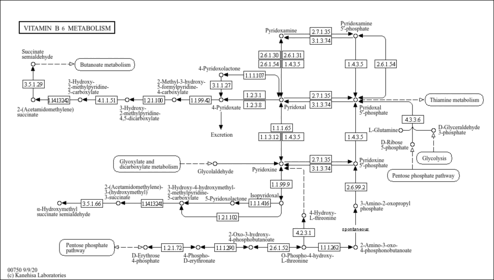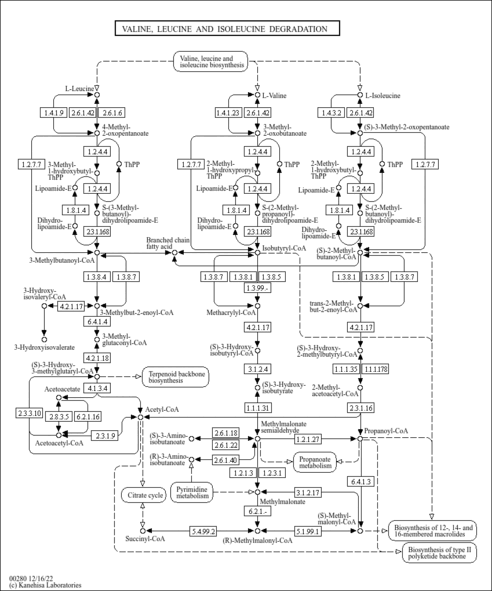| Record Information |
|---|
| Version | 1.0 |
|---|
| Created at | 2020-04-17 18:50:49 UTC |
|---|
| Updated at | 2020-12-07 19:11:17 UTC |
|---|
| CannabisDB ID | CDB004922 |
|---|
| Secondary Accession Numbers | Not Available |
|---|
| Cannabis Compound Identification |
|---|
| Common Name | Pyridoxal |
|---|
| Description | Pyridoxal, also known as pyridoxaldehyde, belongs to the class of organic compounds known as pyridoxals and derivatives. Pyridoxals and derivatives are compounds containing a pyridoxal moiety, which consists of a pyridine ring substituted at positions 2,3,4, and 5 by a methyl group, a hydroxyl group, a carbaldehyde group, and a hydroxymethyl group, respectively. The 4-carboxyaldehyde form of vitamin B 6 which is converted to pyridoxal phosphate which is a coenzyme for synthesis of amino acids, neurotransmitters (serotonin, norepinephrine), sphingolipids, aminolevulinic acid. Pyridoxal is a strong basic compound (based on its pKa). Pyridoxal exists in all living species, ranging from bacteria to humans. In humans, pyridoxal is involved in glycine and serine metabolism. Outside of the human body, Pyridoxal is found, on average, in the highest concentration within milk (cow). Pyridoxal has also been detected, but not quantified in, several different foods, such as tarragons, peppermints, jicama, shallots, and dandelions. This could make pyridoxal a potential biomarker for the consumption of these foods. Pyridoxal is a potentially toxic compound. Pyridoxal is the precursor to pyridoxal phosphate. Pyridoxal is expected to be in Cannabis as all living plants are known to produce and metabolize it. |
|---|
| Structure | |
|---|
| Synonyms | | Value | Source |
|---|
| 3-HYDROXY-5-(hydroxymethyl)-2-methylisonicotinaldehyde | ChEBI | | Pyridoxaldehyde | ChEBI | | 3-Hydroxy-5-(hydroxymethyl)-2-methylpyridine-4-carboxaldehyde | HMDB |
|
|---|
| Chemical Formula | C8H9NO3 |
|---|
| Average Molecular Weight | 167.16 |
|---|
| Monoisotopic Molecular Weight | 167.0582 |
|---|
| IUPAC Name | 3-hydroxy-5-(hydroxymethyl)-2-methylpyridine-4-carbaldehyde |
|---|
| Traditional Name | pyridoxal |
|---|
| CAS Registry Number | 66-72-8 |
|---|
| SMILES | CC1=NC=C(CO)C(C=O)=C1O |
|---|
| InChI Identifier | InChI=1S/C8H9NO3/c1-5-8(12)7(4-11)6(3-10)2-9-5/h2,4,10,12H,3H2,1H3 |
|---|
| InChI Key | RADKZDMFGJYCBB-UHFFFAOYSA-N |
|---|
| Chemical Taxonomy |
|---|
| Description | Belongs to the class of organic compounds known as pyridoxals and derivatives. Pyridoxals and derivatives are compounds containing a pyridoxal moiety, which consists of a pyridine ring substituted at positions 2,3,4, and 5 by a methyl group, a hydroxyl group, a carbaldehyde group, and a hydroxymethyl group, respectively. |
|---|
| Kingdom | Organic compounds |
|---|
| Super Class | Organoheterocyclic compounds |
|---|
| Class | Pyridines and derivatives |
|---|
| Sub Class | Pyridine carboxaldehydes |
|---|
| Direct Parent | Pyridoxals and derivatives |
|---|
| Alternative Parents | |
|---|
| Substituents | - Pyridoxal
- Aryl-aldehyde
- Hydroxypyridine
- Methylpyridine
- Vinylogous acid
- Heteroaromatic compound
- Azacycle
- Hydrocarbon derivative
- Aldehyde
- Alcohol
- Organic oxygen compound
- Aromatic alcohol
- Organic nitrogen compound
- Primary alcohol
- Organooxygen compound
- Organonitrogen compound
- Organopnictogen compound
- Organic oxide
- Aromatic heteromonocyclic compound
|
|---|
| Molecular Framework | Aromatic heteromonocyclic compounds |
|---|
| External Descriptors | |
|---|
| Ontology |
|---|
|
| Physiological effect | Health effect: |
|---|
| Disposition | Route of exposure: Source: Biological location: |
|---|
| Role | Industrial application: |
|---|
| Physical Properties |
|---|
| State | Solid |
|---|
| Experimental Properties | | Property | Value | Reference |
|---|
| Melting Point | 165 °C | Not Available | | Boiling Point | Not Available | Not Available | | Water Solubility | 500 mg/mL | Not Available | | logP | Not Available | Not Available |
|
|---|
| Predicted Properties | [] |
|---|
| Spectra |
|---|
| EI-MS/GC-MS | | Type | Description | Splash Key | View |
|---|
| GC-MS | Pyridoxal, non-derivatized, GC-MS Spectrum | splash10-00di-2690000000-5d018202be238b10582a | Spectrum | | GC-MS | Pyridoxal, non-derivatized, GC-MS Spectrum | splash10-0aou-3974000000-8c963fdc714896ad343a | Spectrum | | GC-MS | Pyridoxal, non-derivatized, GC-MS Spectrum | splash10-001j-0590000000-ed8a55680a0c9fa9cbaf | Spectrum | | GC-MS | Pyridoxal, 1 MEOX; 2 TMS, GC-MS Spectrum | splash10-0a4i-5695000000-bd3bb22a5dd4a600cb6c | Spectrum | | GC-MS | Pyridoxal, 1 MEOX; 2 TMS, GC-MS Spectrum | splash10-0aor-5895000000-e55e01ca30d17d2a8a72 | Spectrum | | GC-MS | Pyridoxal, non-derivatized, GC-MS Spectrum | splash10-0a4i-5695000000-bd3bb22a5dd4a600cb6c | Spectrum | | GC-MS | Pyridoxal, non-derivatized, GC-MS Spectrum | splash10-0aor-5895000000-e55e01ca30d17d2a8a72 | Spectrum | | Predicted GC-MS | Pyridoxal, non-derivatized, Predicted GC-MS Spectrum - 70eV, Positive | splash10-000i-1900000000-56d1f96c5ac868ce42a6 | Spectrum | | Predicted GC-MS | Pyridoxal, 2 TMS, Predicted GC-MS Spectrum - 70eV, Positive | splash10-00fs-6190000000-78d7f54ce0c5338f815f | Spectrum | | Predicted GC-MS | Pyridoxal, non-derivatized, Predicted GC-MS Spectrum - 70eV, Positive | Not Available | Spectrum |
|
|---|
| MS/MS | | Type | Description | Splash Key | View |
|---|
| MS/MS | LC-MS/MS Spectrum - Quattro_QQQ 10V, Positive (Annotated) | splash10-0002-0900000000-4ce3f52baa36006ef4b2 | 2012-07-24 | View Spectrum | | MS/MS | LC-MS/MS Spectrum - Quattro_QQQ 25V, Positive (Annotated) | splash10-00kg-9500000000-658a96f6cda4a96de045 | 2012-07-24 | View Spectrum | | MS/MS | LC-MS/MS Spectrum - Quattro_QQQ 40V, Positive (Annotated) | splash10-0gbc-9000000000-233fc8ab067b0dcd1f14 | 2012-07-24 | View Spectrum | | MS/MS | LC-MS/MS Spectrum - LC-ESI-QQ (API3000, Applied Biosystems) 10V, Negative | splash10-014i-0900000000-c49b207cafcf1c21302d | 2012-08-31 | View Spectrum | | MS/MS | LC-MS/MS Spectrum - LC-ESI-QQ (API3000, Applied Biosystems) 20V, Negative | splash10-000i-0900000000-cad83f5f123a879fa0bb | 2012-08-31 | View Spectrum | | MS/MS | LC-MS/MS Spectrum - LC-ESI-QQ (API3000, Applied Biosystems) 30V, Negative | splash10-0a4i-0900000000-4f12feae0e11a6d9016b | 2012-08-31 | View Spectrum | | MS/MS | LC-MS/MS Spectrum - LC-ESI-QQ (API3000, Applied Biosystems) 40V, Negative | splash10-0a4i-2900000000-56fcdbb9b4363c84d2d0 | 2012-08-31 | View Spectrum | | MS/MS | LC-MS/MS Spectrum - LC-ESI-QQ (API3000, Applied Biosystems) 50V, Negative | splash10-056r-9400000000-9700c9585f6c540bf007 | 2012-08-31 | View Spectrum | | MS/MS | LC-MS/MS Spectrum - LC-ESI-QQ (API3000, Applied Biosystems) 10V, Positive | splash10-0gb9-0900000000-e646a99b0c1521d1c8dd | 2012-08-31 | View Spectrum | | MS/MS | LC-MS/MS Spectrum - LC-ESI-QQ (API3000, Applied Biosystems) 20V, Positive | splash10-0udi-0900000000-8fce1a7d8ceb3fced3ed | 2012-08-31 | View Spectrum | | MS/MS | LC-MS/MS Spectrum - LC-ESI-QQ (API3000, Applied Biosystems) 30V, Positive | splash10-0udl-6900000000-e2fc0eaa17e57d0a2556 | 2012-08-31 | View Spectrum | | MS/MS | LC-MS/MS Spectrum - LC-ESI-QQ (API3000, Applied Biosystems) 40V, Positive | splash10-00kf-9200000000-0bda29931f8b6f2fcc77 | 2012-08-31 | View Spectrum | | MS/MS | LC-MS/MS Spectrum - LC-ESI-QQ (API3000, Applied Biosystems) 50V, Positive | splash10-014l-9000000000-469c127d1aef4f8a51d7 | 2012-08-31 | View Spectrum | | MS/MS | LC-MS/MS Spectrum - LC-ESI-QTOF (UPLC Q-Tof Premier, Waters) , Positive | splash10-0udi-2900000000-63ebef5a0818d6a1ccb8 | 2012-08-31 | View Spectrum | | MS/MS | LC-MS/MS Spectrum - LC-ESI-QTOF (UPLC Q-Tof Premier, Waters) , Negative | splash10-05n0-0900000000-f468a00d88bedc116485 | 2012-08-31 | View Spectrum | | MS/MS | LC-MS/MS Spectrum - LC-ESI-QQ , negative | splash10-014i-0900000000-c49b207cafcf1c21302d | 2017-09-14 | View Spectrum | | MS/MS | LC-MS/MS Spectrum - LC-ESI-QQ , negative | splash10-000i-0900000000-bf0686eb8e3c28c30e85 | 2017-09-14 | View Spectrum | | MS/MS | LC-MS/MS Spectrum - LC-ESI-QQ , negative | splash10-0a4i-0900000000-686848e0f222273e5089 | 2017-09-14 | View Spectrum | | MS/MS | LC-MS/MS Spectrum - LC-ESI-QQ , negative | splash10-0a4i-2900000000-99577e7f4a39e47c5c42 | 2017-09-14 | View Spectrum | | Predicted MS/MS | Predicted LC-MS/MS Spectrum - 10V, Positive | splash10-0uxr-0900000000-7f4ef736d1a810b2e8ab | 2015-05-27 | View Spectrum | | Predicted MS/MS | Predicted LC-MS/MS Spectrum - 20V, Positive | splash10-0udi-0900000000-9c4ead9423b52a47b2fe | 2015-05-27 | View Spectrum | | Predicted MS/MS | Predicted LC-MS/MS Spectrum - 40V, Positive | splash10-0udi-9500000000-aa6a11948622748c8469 | 2015-05-27 | View Spectrum | | Predicted MS/MS | Predicted LC-MS/MS Spectrum - 10V, Negative | splash10-014i-0900000000-dd6386614990770eaae5 | 2015-05-27 | View Spectrum | | Predicted MS/MS | Predicted LC-MS/MS Spectrum - 20V, Negative | splash10-000i-0900000000-e9de9bab2598f0316525 | 2015-05-27 | View Spectrum | | Predicted MS/MS | Predicted LC-MS/MS Spectrum - 40V, Negative | splash10-0abc-9300000000-f4bc767c42577b6a1d5f | 2015-05-27 | View Spectrum |
|
|---|
| NMR | | Type | Description | | View |
|---|
| 1D NMR | 1H NMR Spectrum (1D, 500 MHz, H2O, experimental) | | Spectrum | | 1D NMR | 1H NMR Spectrum (1D, D2O, experimental) | | Spectrum | | 1D NMR | 13C NMR Spectrum (1D, D2O, experimental) | | Spectrum | | 1D NMR | 1H NMR Spectrum (1D, 100 MHz, D2O, predicted) | | Spectrum | | 1D NMR | 13C NMR Spectrum (1D, 100 MHz, D2O, predicted) | | Spectrum | | 1D NMR | 1H NMR Spectrum (1D, 1000 MHz, D2O, predicted) | | Spectrum | | 1D NMR | 13C NMR Spectrum (1D, 1000 MHz, D2O, predicted) | | Spectrum | | 1D NMR | 1H NMR Spectrum (1D, 200 MHz, D2O, predicted) | | Spectrum | | 1D NMR | 13C NMR Spectrum (1D, 200 MHz, D2O, predicted) | | Spectrum | | 1D NMR | 1H NMR Spectrum (1D, 300 MHz, D2O, predicted) | | Spectrum | | 1D NMR | 13C NMR Spectrum (1D, 300 MHz, D2O, predicted) | | Spectrum | | 1D NMR | 1H NMR Spectrum (1D, 400 MHz, D2O, predicted) | | Spectrum | | 1D NMR | 13C NMR Spectrum (1D, 400 MHz, D2O, predicted) | | Spectrum | | 1D NMR | 1H NMR Spectrum (1D, 500 MHz, D2O, predicted) | | Spectrum | | 1D NMR | 13C NMR Spectrum (1D, 500 MHz, D2O, predicted) | | Spectrum | | 1D NMR | 1H NMR Spectrum (1D, 600 MHz, D2O, predicted) | | Spectrum | | 1D NMR | 13C NMR Spectrum (1D, 600 MHz, D2O, predicted) | | Spectrum | | 1D NMR | 1H NMR Spectrum (1D, 700 MHz, D2O, predicted) | | Spectrum | | 1D NMR | 13C NMR Spectrum (1D, 700 MHz, D2O, predicted) | | Spectrum | | 1D NMR | 1H NMR Spectrum (1D, 800 MHz, D2O, predicted) | | Spectrum | | 1D NMR | 13C NMR Spectrum (1D, 800 MHz, D2O, predicted) | | Spectrum | | 1D NMR | 1H NMR Spectrum (1D, 900 MHz, D2O, predicted) | | Spectrum | | 1D NMR | 13C NMR Spectrum (1D, 900 MHz, D2O, predicted) | | Spectrum | | 2D NMR | [1H, 13C]-HSQC NMR Spectrum (2D, 600 MHz, H2O, experimental) | | Spectrum |
|
|---|
| Pathways |
|---|
| Pathways | | Name | SMPDB/Pathwhiz | KEGG | | Vitamin B6 Metabolism |    |  | | Hypophosphatasia |    | Not Available | | Valine, Leucine and Isoleucine Degradation |    |  | | Beta-Ketothiolase Deficiency |    | Not Available | | 2-Methyl-3-Hydroxybutryl CoA Dehydrogenase Deficiency |    | Not Available |
|
|---|
| Protein Targets |
|---|
| Enzymes | |
|---|
| Transporters | Not Available |
|---|
| Metal Bindings | |
|---|
| Receptors | Not Available |
|---|
| Transcriptional Factors | Not Available |
|---|
| Concentrations Data |
|---|
| Not Available |
|---|
| External Links |
|---|
| HMDB ID | HMDB0001545 |
|---|
| DrugBank ID | DB00147 |
|---|
| Phenol Explorer Compound ID | Not Available |
|---|
| FoodDB ID | FDB011169 |
|---|
| KNApSAcK ID | C00007509 |
|---|
| Chemspider ID | 1021 |
|---|
| KEGG Compound ID | C00250 |
|---|
| BioCyc ID | PYRIDOXAL |
|---|
| BiGG ID | 34393 |
|---|
| Wikipedia Link | Pyridoxal |
|---|
| METLIN ID | 6312 |
|---|
| PubChem Compound | 1050 |
|---|
| PDB ID | Not Available |
|---|
| ChEBI ID | 17310 |
|---|
| References |
|---|
| General References | Not Available |
|---|

